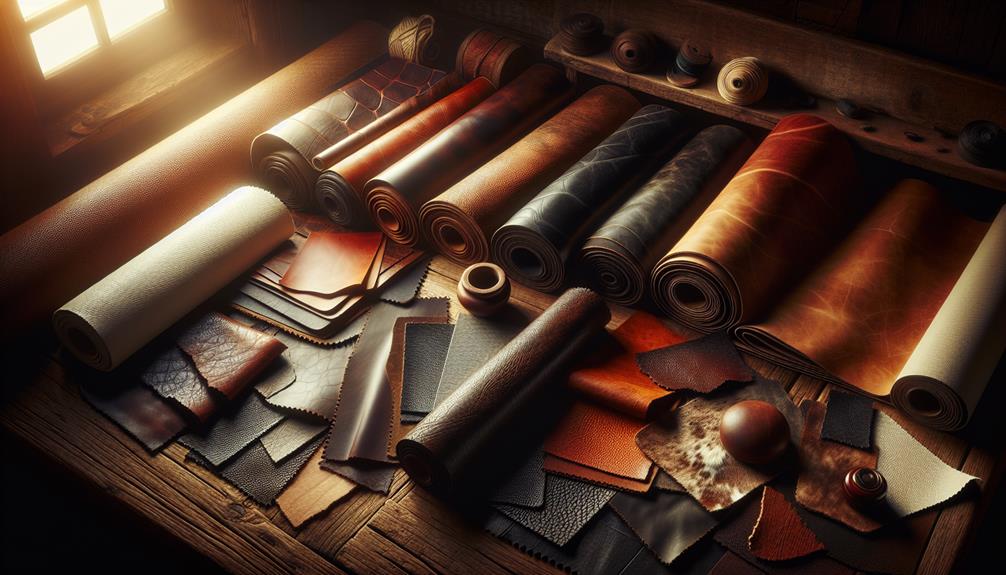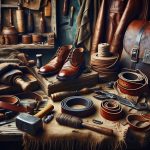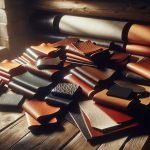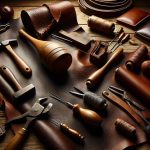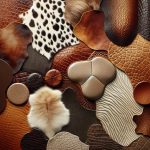I've found that full-grain leather is considered the most authentic leather you can get. It keeps the natural grain of the hide, which means it holds up really well over time and even gets better with age. Each piece is unique, showing off its own marks and imperfections that tell a story. Whether it's for a rugged pair of boots or a sleek, upscale bag, full-grain leather combines style with serious longevity. It's not just tough; it also develops a beautiful patina that showcases its quality. There's a lot more to uncover about why full-grain leather stands out.
Table of Contents
Key Takeaways
- Full-grain leather is the most authentic, retaining the hide's natural textures and imperfections.
- It is known for its durability and ability to develop a unique patina over time.
- Full-grain leather undergoes minimal processing, preserving its natural characteristics and strength.
- This grade of leather is preferred for luxury goods due to its quality and longevity.
- The natural grain of full-grain leather showcases genuine marks like scars and wrinkles, adding to its authenticity.
Defining Authentic Leather
Authentic leather is genuine leather made from the hides of animals, not synthetic materials. This type of leather is renowned for its quality and durability, making it a top choice for those who appreciate fine craftsmanship. It comes in various grades, notably full-grain, top-grain, and genuine leather, each offering different characteristics and levels of quality.
Full-grain leather is the cream of the crop in terms of authenticity. It includes the entire grain with all its natural imperfections, which many believe adds character and uniqueness to the leather. These imperfections aren't flaws; rather, they're proof of the leather's genuine origin and make each piece one-of-a-kind.
On the other hand, top-grain leather is also high quality but slightly less raw than full-grain. It's processed to remove imperfections from the surface, giving it a more uniform look. This treatment makes top-grain leather more resistant to stains than full-grain, though it retains less of the original texture of the hide.
Genuine leather, while still real leather, doesn't specify a particular layer of the hide. It varies significantly in quality and generally lacks the durability and unique characteristics of the higher grades.
The Uniqueness of Full-Grain
Full-grain leather stands out due to its complete retention of the hide's natural grain, making it the highest quality and most authentic type available. This isn't just another type of genuine leather; it's the real deal. When I talk about the character of full-grain, I'm referring to its rugged durability and how it resists wear and tear. It's built to last, perfect for items you use every day.
Each piece of full-grain leather is unique. The untouched surface means you get to see all the unique markings of the hide. These aren't flaws; they're badges of authenticity and character that make each leather product one-of-a-kind. Think about how a well-made leather bag or wallet gets better with age—that's the magic of full-grain. It develops a rich patina that deepens the color and enhances the texture over time.
Why settle for less when you can have the best? Full-grain leather is top quality, not just because it's tough, but because it carries a piece of natural beauty that faux and lower-grade leathers can't match. It's the ideal choice for anyone looking to combine style with longevity in their leather goods.
Distinguishing Marks and Imperfections
When I look at full-grain leather, I'm always captivated by its natural grain variations and the stories they tell.
Scars and wrinkles aren't just imperfections; they're proof of a genuine, well-lived past.
These unique features ensure no two pieces are exactly alike, adding a personal touch to each item.
Natural Grain Variations
Every piece of leather is unique, thanks to natural grain variations like scars, wrinkles, and stretch marks. These imperfections aren't flaws; they're proof of authentic leather. In fact, when I look for high-quality, full-grain leather, I'm not just looking for something that will last, I'm looking for a story. Each mark tells a tale of the animal's life, and I cherish the genuine uniqueness this brings.
- Full-grain leather retains these natural textures, ensuring durability and a one-of-a-kind appearance.
- Authentic leather celebrates these variations, differentiating it from processed alternatives.
- Natural grain variations are the hallmarks of quality, indicating that the leather hasn't been corrected or sanded down.
These characteristics aren't just visually appealing—they're desirable features that enhance the value and appeal of leather goods.
Scars and Wrinkles
Scars and wrinkles aren't just imperfections; they're what make each piece of leather uniquely beautiful. When I look at a genuine leather item, the scars from healed wounds or insect bites, and the wrinkles that form over time tell a rich story. These marks aren't flaws; rather, they add a distinct character and a touch of authenticity you just can't find in synthetic materials.
These natural features signify the leather's journey and showcase its quality. Each crease and scar enhances the material's charm, making it more desirable. For anyone who values realness and history in their leather goods, these imperfections aren't just accepted; they're celebrated.
Processing and Manufacturing
Now, let's talk about how the most authentic leather is made.
We'll look at different tanning methods, explore various leather cutting techniques, and see how finishing touches are applied to leather surfaces.
Each of these steps is crucial in defining the quality and appearance of the final product.
Tanning Methods Explored
Let's dive into the two main methods used for tanning leather: vegetable tanning and chrome tanning. When it comes to leather tanning methods, these two are quite distinct.
Vegetable-tanned leather utilizes natural tannins extracted from tree bark, plants, and fruits, offering a rich aroma and the ability to develop a unique patina. On the other hand, chrome tanned leather involves chromium salts, making the process quicker but less eco-friendly.
- Vegetable Tanning: Eco-friendly, enriches leather's natural qualities.
- Chrome Tanning: Quick and efficient, uses chromium salts.
- Patina Development: Vegetable-tanned leather uniquely ages over time.
Each method significantly influences the leather's final look, feel, and sustainability. As you explore leather, consider how these processes impact both the environment and your product's character.
Leather Cutting Techniques
In leather processing, cutting techniques like clicking, skiving, splitting, and embossing are crucial for shaping and detailing the final products.
Clicking lets me precisely cut out specific shapes from the leather, which is perfect for customized designs.
Skiving is next; it's where I thin the edges of the leather. This makes the seams less bulky and more refined, which is essential for high-quality leather goods.
Splitting is about reducing the leather's thickness. I use this mostly for items that need flexibility, like wallets and belts.
Lastly, embossing adds a unique touch by imprinting patterns or branding directly onto the leather's surface, using a combination of heat and pressure.
Each of these techniques plays a vital role in crafting top-notch leather products.
Finishing Leather Surfaces
After cutting and shaping, I move on to finishing the leather surfaces, which involves sanding, dyeing, and applying protective coatings to boost both look and longevity. This stage is crucial because it not only enhances the appearance but also significantly increases the durability of the leather products. The techniques I use are designed to achieve specific textures and effects that meet the demands of high-quality craftsmanship.
- Sanding: Smooths the leather, preparing it for even dye application.
- Dyeing: Adds depth and richness of color, allowing for customization.
- Protective Coatings: Seal in color and provide a barrier against moisture and wear.
Each step is vital to creating a product that's not only beautiful but also long-lasting and resistant to the elements.
Durability and Longevity
Full-grain leather really stands the test of time, outshining other types with its unmatched durability and longevity. When you're looking for something that lasts, this is your go-to material. The secret behind its robustness? It's all in the natural grain. This layer is where the toughest fibers live, giving full-grain leather a leg up in durability.
What's more, full-grain leather doesn't just endure; it does so while maintaining its structural integrity. This means it holds up under stress without falling apart, making it ideal for everything from high-quality boots to durable sofas. As it ages, it doesn't just survive; it thrives, developing a unique patina that adds character without compromising on strength.
The Patina Development Process
Over time, the natural aging process enhances full-grain leather with a patina that uniquely reflects its history and use. As a lover of all things authentic and of high quality, I've always been fascinated by the patina development process. It's not just about the leather aging; it's about how it ages beautifully and tells a story.
Here's why the patina on full-grain leather is so prized:
- Natural Beauty: Each piece develops a patina that's utterly unique. This isn't something you can fake or rush. It's a natural art.
- Indicator of Quality: A well-developed patina is a testament to the quality of the leather. Only high-grade, full-grain leather can develop such a rich and enchanting patina.
- Sign of Craftsmanship: The appearance of patina over time also speaks to the craftsmanship involved in creating the leather product. It's a feature that lovers of fine craftsmanship seek out.
The interaction between the leather, the environment, and how it's used all contribute to this beautiful transformation. For anyone who values quality and authenticity in their leather goods, watching a patina develop over time is like watching a masterpiece in progress. It's truly one of the defining characteristics of high-quality, authentic leather.
Luxury Products and Uses
Luxury brands often choose full-grain leather for their products because of its unmatched quality and durability. When I'm eyeing luxury leather goods, I know that full-grain leather means I'm getting something robust and beautiful. This type of leather isn't just durable; it also develops a patina that enhances its aesthetic appeal over time, making each piece uniquely mine.
Italian leather is a term you hear often when talking about luxury items. It's synonymous with high-quality and authenticity. The reason? Italian tanneries use traditional methods to produce full-grain leather that retains the original textures of the hide, giving it that exclusive, luxurious feel that's hard to find elsewhere.
If you're into luxury goods, you'll notice that high-end brands are very particular about the materials they use. They go for the best, and authentic, full-grain leather is often their top choice. Whether it's a sleek wallet, a sophisticated handbag, or even elegant upholstery, these products stand out because they're crafted from the finest leather. Each item not only looks splendid but is built to last, ensuring that luxury feel remains for years to come.
Care and Maintenance Tips
To keep your leather looking great, it's crucial to regularly clean and condition it. When I first got into leather products, I didn't realize how maintenance could make such a difference. But trust me, caring for your leather not only prolongs its life but also keeps it looking as luxurious as when you first bought it.
Here's a straightforward approach to leather care that I've found incredibly effective:
- Clean gently but thoroughly. Always use a cleaner specifically designed for leather. Apply it with a soft cloth, working in a circular motion to lift dirt without scratching the surface.
- Condition to restore moisture. After cleaning, apply a good-quality leather conditioner. This helps prevent the leather from drying out and cracking, which is essential for maintaining its supple feel and appearance.
- Avoid harmful elements. Keep your leather products away from direct sunlight and heat sources to avoid fading and deterioration. Also, steer clear of harsh chemicals that can damage the leather.
Comparing Leather Grades
When comparing leather grades, it's clear that full-grain leather stands out as the highest quality due to its durability and natural characteristics. This type of leather retains the original texture and markings of the hide, making each piece unique and highly authentic. It's the go-to for anyone seeking top-tier, long-lasting products.
Moving a step down, top-grain leather is also impressive. It's refined to remove imperfections and thus has a smoother finish. While it doesn't boast the same rugged durability as full-grain, top-grain leather still offers significant endurance and aesthetic appeal. It's a solid choice for those who prioritize a more consistent look over the ruggedness of full-grain.
On the other hand, genuine leather is a bit of a mixed bag. It includes all kinds of real leather but generally refers to lower-quality options. It's less durable and not as rich in appearance as its higher-grade counterparts.
And then there's bonded leather, which frankly, I'd say is at the bottom of the pile. It's made from leftover scraps and synthetic materials, prone to damage and lacks the authenticity leather enthusiasts crave.
Frequently Asked Questions
What Is the Most Genuine Leather?
I'd say the most genuine leather is full-grain. It keeps the entire hide, showing natural marks and lasting long. It's top-notch for durability and gains a beautiful patina, enhancing its character.
What Is 100% Genuine Leather?
I've learned that 100% genuine leather means it's all real animal hide, not mixed with anything fake. It's not about quality grade but guarantees you're getting the real deal, no synthetics involved.
What Are the 4 Grades of Leather?
The four grades of leather are full-grain, top-grain, split-grain, and bonded leather. Each varies in quality, durability, and finish, suiting different needs and preferences in products like bags, shoes, and furniture.
Which Leather Is Original?
The original leather you're asking about is full-grain leather. It's the top layer of the hide, keeping all natural features. It's durable, develops a unique look over time, and is highly authentic.
- How Does Ring Spun Cotton Affect Garment Fit and Shape Retention? - August 13, 2024
- What Are the Challenges in Producing Ring Spun Cotton? - August 13, 2024
- Is Ring Spun Cotton Suitable for Plus-Size Clothing? - August 13, 2024

